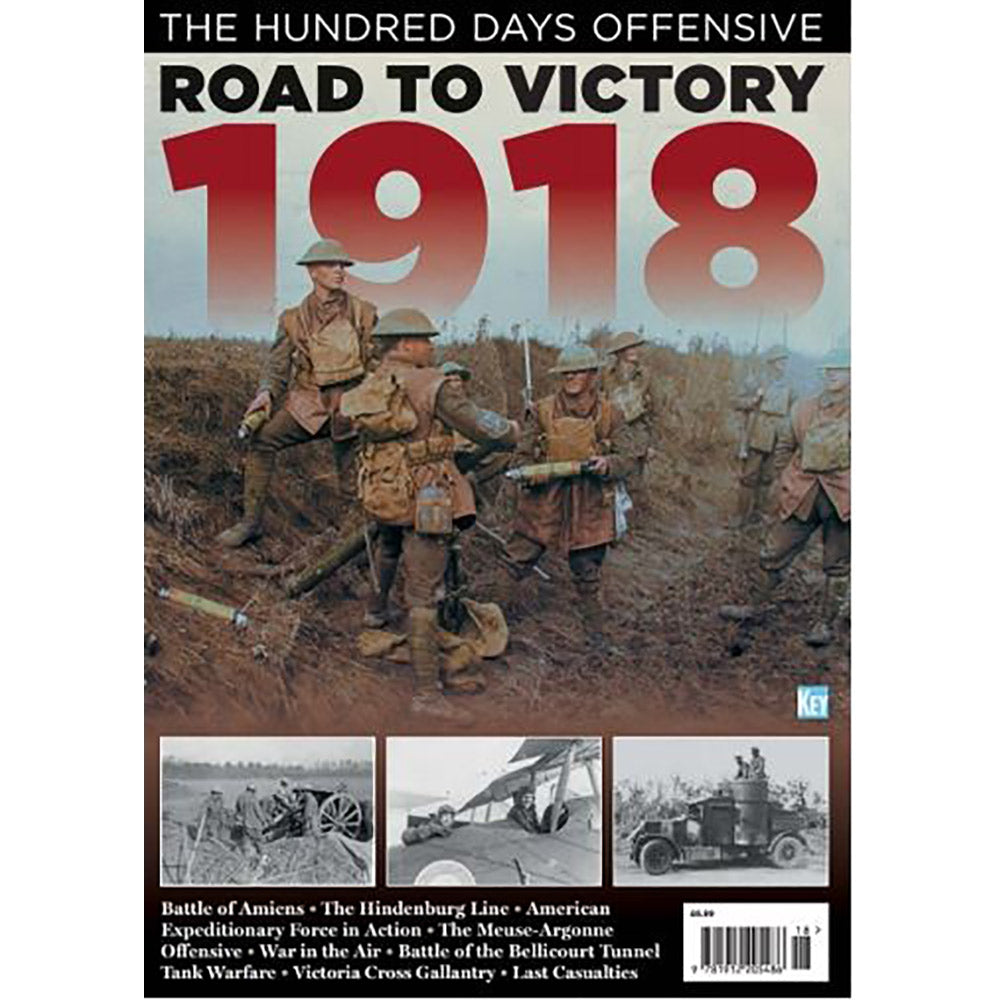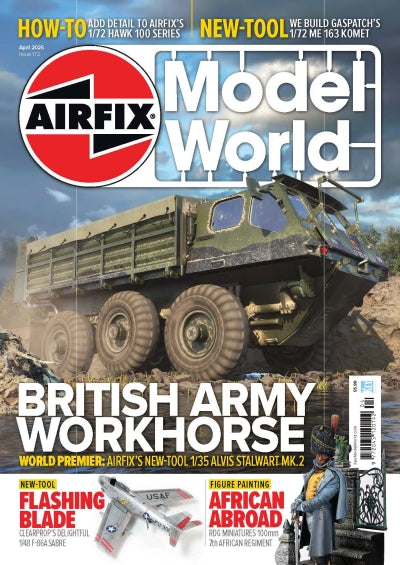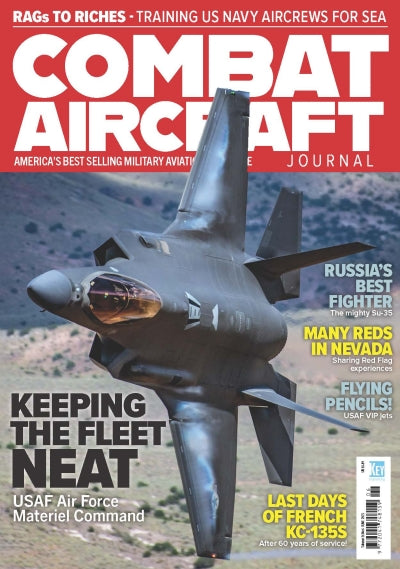Road to Victory 1918
Road to Victory 1918
Road to Victory 1918
Road to Victory 1918
Road to Victory 1918 reveals how, after so many years of trench warfare, the fighting on the Western Front became mobile and more fluid. It reveals how the fighting of 1918 was truly a multi-national effort, including the British, French, Australians, Canadians, New Zealanders, Americans and Belgians.
This beautifully presented publication also details the role of the RAF in the air, the use of tanks on the ground and the lengths the enemy went to in an attempt to slow the Allied advance and their prolific use of booby traps. Additionally, Road to Victory explores the Battle of Saint-Mihiel, the Australians at Mont St Quentin, the events at Cheppy where the legend that was General George S Patton was born and the last battles played out on the Western Front in the final days of the First World War.
Featuring:
THE BEGINNING OF THE END
Four years of warfare had seen an evolution in tactics and a gradual growth in the strength and capability of the Allied armies. Now everything that had been learnt on the bloody battlefields of the Western Front would be put into practice in one unremitting offensive campaign.
MEN AND MATERIEL
By the summer of 1918, the Allies held the advantage in almost every important aspect from manpower to machines.
THE TURN OF THE TIDE
After four years of virtual stagnation, with advances being measured by the yard, in 1918 the front line moved scores of miles south and westwards as the Allies found themselves fighting with their backs to the wall.
RETURN TO THE SOMME
It was across the battlefields of the Somme that the Allies had to advance again during the summer of 1918.
THE GREATEST MILITARY ACHIEVEMENT OF THE WAR
On the night of 31 August 1918, the men of the Australian Corps stormed, seized and held the key height of Mont St. Quentin.
NOT A FURTHER STEP BACK
The Hindenburg Line was supposed to be the most formidable field fortification ever built on the Western Front, one that would hold the enemy at bay indefinitely.
THE AMERICANS GO IT ALONE
On 12 September 1918, the American Expeditionary Force launched its first solo offensive of the Great War the Battle of Saint-Mihiel.
THE MEUSE-ARGONNE OFFENSIVE
The offensive in the Meuse-Argonne region would prove to be the largest and bloodiest American operation of the First World War.
AN OPERATIONAL MASTERPIECE
The hard-fought victory at the Canal du Nord remains among the most impressive engagements fought by the Canadian Corps during the First World War.
A SACRIFICIAL STUNT
On 29 September 1918, the 46th (North Midland) Division stormed the St Quentin Canal, resulting in the first full breach of the Hindenburg Line.
THE WAR IN THE AIR
By the start of the Hundred Days Offensive, the Royal Air Force ruled the skies and dominated the battlefield.
THE BATTLE OF BELLICOURT TUNNEL
There was one part of the St Quentin Canal where the waterway travelled underground through the Bellicourt Tunnel. It was hoped that this would provide an easy route over the canal it proved anything but.
THE METAL MONSTERS
By 1918, and the Hundred Days Offensive, tanks were considered an essential component of any offensive operation.
THE CAPTURE OF CAMBRAI
The key communications hub of Cambrai had been in German hands since the early months of the war. By the end of September, it had become an Allied target.
THE UNSEEN ENEMY
As the Germans retreated throughout the autumn of 1918 they left behind a battlefield littered with booby traps, mines and delayed-action devices.
THE MARCH TO VICTORY
It was evident to all concerned that the German Army was on the verge of collapse, yet the fighting continued.
BREAKING THE ENEMY'S RESISTANCE
Standing in the way of the Allied advance was the old walled town of Le Quesnoy. It had to be taken the old fashioned way by scaling its walls.
THE LAST SHOT
Nothing could exemplify the utter futility of war than the final few moments of the First World War. For the last shot fired by British soldiers is said to have taken place at Mons, where the first British shot had been fired in 1914. and much more!
ISBN: 9781912205486
The Key Publishing Promise

A specialist media company serving the enthusiast community across the globe. Trusted for over 40 years.
Buy Direct and Save
Subscriber Only Discounts across the store
Get early access to exclusive events and product Launches

Road to Victory 1918 reveals how, after so many years of trench warfare, the fighting on the Western Front became mobile and more fluid. It reveals how the fighting of 1918 was truly a multi-national effort, including the British, French, Australians, Canadians, New Zealanders, Americans and Belgians.
This beautifully presented publication also details the role of the RAF in the air, the use of tanks on the ground and the lengths the enemy went to in an attempt to slow the Allied advance and their prolific use of booby traps. Additionally, Road to Victory explores the Battle of Saint-Mihiel, the Australians at Mont St Quentin, the events at Cheppy where the legend that was General George S Patton was born and the last battles played out on the Western Front in the final days of the First World War.
Featuring:
THE BEGINNING OF THE END
Four years of warfare had seen an evolution in tactics and a gradual growth in the strength and capability of the Allied armies. Now everything that had been learnt on the bloody battlefields of the Western Front would be put into practice in one unremitting offensive campaign.
MEN AND MATERIEL
By the summer of 1918, the Allies held the advantage in almost every important aspect from manpower to machines.
THE TURN OF THE TIDE
After four years of virtual stagnation, with advances being measured by the yard, in 1918 the front line moved scores of miles south and westwards as the Allies found themselves fighting with their backs to the wall.
RETURN TO THE SOMME
It was across the battlefields of the Somme that the Allies had to advance again during the summer of 1918.
THE GREATEST MILITARY ACHIEVEMENT OF THE WAR
On the night of 31 August 1918, the men of the Australian Corps stormed, seized and held the key height of Mont St. Quentin.
NOT A FURTHER STEP BACK
The Hindenburg Line was supposed to be the most formidable field fortification ever built on the Western Front, one that would hold the enemy at bay indefinitely.
THE AMERICANS GO IT ALONE
On 12 September 1918, the American Expeditionary Force launched its first solo offensive of the Great War the Battle of Saint-Mihiel.
THE MEUSE-ARGONNE OFFENSIVE
The offensive in the Meuse-Argonne region would prove to be the largest and bloodiest American operation of the First World War.
AN OPERATIONAL MASTERPIECE
The hard-fought victory at the Canal du Nord remains among the most impressive engagements fought by the Canadian Corps during the First World War.
A SACRIFICIAL STUNT
On 29 September 1918, the 46th (North Midland) Division stormed the St Quentin Canal, resulting in the first full breach of the Hindenburg Line.
THE WAR IN THE AIR
By the start of the Hundred Days Offensive, the Royal Air Force ruled the skies and dominated the battlefield.
THE BATTLE OF BELLICOURT TUNNEL
There was one part of the St Quentin Canal where the waterway travelled underground through the Bellicourt Tunnel. It was hoped that this would provide an easy route over the canal it proved anything but.
THE METAL MONSTERS
By 1918, and the Hundred Days Offensive, tanks were considered an essential component of any offensive operation.
THE CAPTURE OF CAMBRAI
The key communications hub of Cambrai had been in German hands since the early months of the war. By the end of September, it had become an Allied target.
THE UNSEEN ENEMY
As the Germans retreated throughout the autumn of 1918 they left behind a battlefield littered with booby traps, mines and delayed-action devices.
THE MARCH TO VICTORY
It was evident to all concerned that the German Army was on the verge of collapse, yet the fighting continued.
BREAKING THE ENEMY'S RESISTANCE
Standing in the way of the Allied advance was the old walled town of Le Quesnoy. It had to be taken the old fashioned way by scaling its walls.
THE LAST SHOT
Nothing could exemplify the utter futility of war than the final few moments of the First World War. For the last shot fired by British soldiers is said to have taken place at Mons, where the first British shot had been fired in 1914. and much more!
ISBN: 9781912205486
All subscriptions are delivered post free. We will make every effort to ensure orders confirmed by 1pm Monday-Friday will be despatched on the same day. Orders confirmed after 1pm are not guaranteed to be despatched on the same day. For overseas orders please allow at least 28 days for delivery, overseas items are sent by surface mail.
Key Publishing charge delivery per entire order, rather than per single product, with the exception of any magazine subscription order, which will not be subject to postage charges. At the checkout page, you will be presented with the appropriate delivery options for your order to allow you to select the option that you prefer. All charges will be made clear prior to you being asked to confirm final payment for your items.
Please note: Subscription purchases do not incur any additional delivery charges.
You may also like

BUSES Yearbook 2025
BUSES Yearbook 2025

Airliner World Magazine Subscription (Print)
Buses Yearbook 2026

Modelling British Railways: Diesel Depots
Modelling British Railways: Diesel Depots

HST - The Definitive Guide

BUSES Yearbook 2024
BUSES Yearbook 2024

British Airpower (2022)
British Airpower (2022)

Modelling British Railways: Modelling Railfreight Sub-Sector
Modelling British Railways: Modelling Railfreight Sub-Sector

Airbus A330

Modelling British Railways DCTM
Modelling British Railways DCTM
Discover Something New

PJM Models OO gauge Crewe North A signalbox laser-cut kit
PJM Models latest exclusive ‘OO’ gauge model replicates Crewe Station A signalbox. The kit builds the compact 1907-built ‘box ...
CIA: America’s Spies and Covert Warriors
Aircraft Carriers: History - Technology - Operations
Battle of the Bulge – The Last Throw of Hitler’s Dice

Handley Page Halifax Bomber Ltd Edition
Handley Page Halifax Bomber Ltd Edition
Pistons, Passengers and Payloads
Lufthansa: The Complete History
Hornby TT:120: One Size Suits All

Why Buy Direct
Key Publishing is a content hub with global reach. Through unrivalled passion and media technology, we connect enthusiasts around the world through expert, informed and engaging content.
Buy Direct and Save
Oustanding customer service
Subscriber Only Discounts across the store
Get early access to exclusive events and product Launches
Buy Direct and Save
Oustanding customer service
Subscriber Only Discounts across the store
Get early access to exclusive events and product Launches
What Our Customers Say



A magazine that truly inspires
I’ve been reading Airliner World for as long as I can remember. A magazine that truly inspires, with great articles and beautiful pictures.
Aaron B

Best on the market
I’d say Airfix Model World is the best on the market. Well laid out, well written and plenty of diversity. Definitely the magazine the others strive to beat
Tim H

Most technically accurate railway magazine
Modern Railways is the most technically accurate railway magazine in the business and with writers of the calibre of Ford, Walmsley and Willias, what is not to like?
Graham H

Gets better every year
I have almost every issue of FlyPast and it gets better every year. Great detailed articles and enjoyable stories in each issue
David L

Spectacular imagery
Between the spectacular imagery and timely articles, I can think of no better magazine related to modern military aviation than Combat Aircraft
Roger F

Subscribing since the 80's!
I started buying Aeroplane Monthly in ‘76 or ‘77. By the early 80’s I bought a subscription and I still have it. I love the magazine.
Chris E

A magazine that truly inspires
I’ve been reading Airliner World for as long as I can remember. A magazine that truly inspires, with great articles and beautiful pictures.
Aaron B

Best on the market
I’d say Airfix Model World is the best on the market. Well laid out, well written and plenty of diversity. Definitely the magazine the others strive to beat
Tim H

Most technically accurate railway magazine
Modern Railways is the most technically accurate railway magazine in the business and with writers of the calibre of Ford, Walmsley and Willias, what is not to like?
Graham H

Gets better every year
I have almost every issue of FlyPast and it gets better every year. Great detailed articles and enjoyable stories in each issue
David L

Spectacular imagery
Between the spectacular imagery and timely articles, I can think of no better magazine related to modern military aviation than Combat Aircraft
Roger F

Subscribing since the 80's!
I started buying Aeroplane Monthly in ‘76 or ‘77. By the early 80’s I bought a subscription and I still have it. I love the magazine.
Chris E
Still Looking?
Need a little inspiration? Try some of our most popular searches to narrow down our treasure trove of products.

Sign up to our newsletter and unlock 10% off your first order*
Plus, become a newsletter subscriber and you’ll receive exclusive content, offers and stay informed about our latest product releases.
- Choosing a selection results in a full page refresh.
- Opens in a new window.













